Global Warming
Introduction
There is clear, unequivocal evidence that the climate of the Earth is warming and has been doing so since at least the beginning of the 20th century. What is the evidence for global warming? How can we be sure that the Earth is actually getting hotter? The most often quoted and most intuitive of supporting data is the increase of surface temperature, worldwide. However, there are multiple sets of independent data that support the conclusion that the Earth's climate is warming.
The lines of evidence are as follows:
- Tropospheric air temperature
- Temperature over land
- Atmospheric water vapor level
- Marine air temperature
- Sea surface temperature
- Ocean heat content
- Sea level
- Sea ice area
- High altitude snow cover
- High latitude snow cover
- Glacier volume
- Changes in extent of permafrost
Global Temperature Land Only 1880-Present
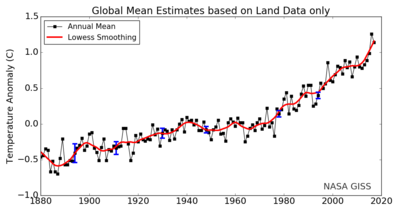
Global Temperature Land Only 1880-2017
Source:NASA GISS Surface Temperature Analysis
Seventeen of the 18 warmest years on record have occurred since 2001. The record starts in 1880, since that is the beginning of our most reliable temperature measurements.
Global Land/Ocean Temperature 1880-Present
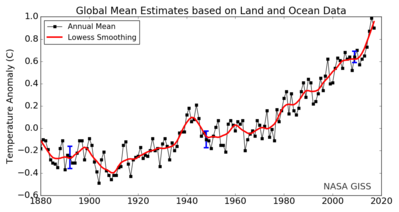
Source: https://data.giss.nasa.gov/gistemp/graphs/
(click image to enlarge)
Since 1880 the average global temperature (land and ocean) has increased by approximately 1°C (1.8°F). The bulk of the energy that contributed to that warming has been absorbed by the oceans, with the rest warming the earth's atmosphere, land areas, polar ice sheets, and glaciers.
Rising Sea Level
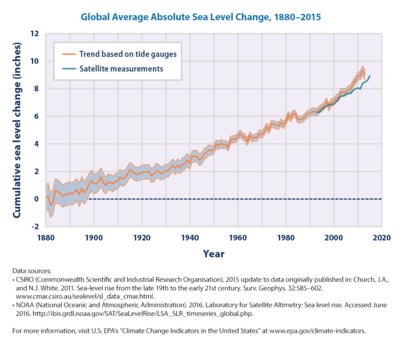
The level of oceans is rising. Since 1993 the average increase has been approximately 2.8 - 3.6 mm per year. That rate of increase is currently accelerating, likely as a result of global warming, and could cause the oceans to rise by the end of the 21st century, depending on the degree of mitigation implemented to limit release of greenhouse gases, by a conservative estimate of a total rise of at least 52 - 98 centimeters. Other estimates place the total rise at 0.3 - 2.5 meters.
The two main causes of increasing sea levels are (1) expansion due to increasing heat content of the oceans, (2) melting of ice caps covering Greenland and Antarctica, and (3) melting of glaciers.
Keeling Curve - Changes in CO2 Levels since 1958
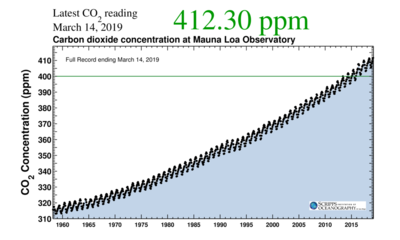
Source: CO2 Atmospheric Concentration at Mauna Loa Observatory
The above chart shows the accelerating increase of carbon dioxide in the atmosphere since 1960. This increase can only be scientifically explained by the steady increase in carbon dioxide emissions from the burning of fossil fuels - coal, oil, and natural gas.
Extreme Weather Events
A recent research report by the American Meteorological Society (AMS) covers 27 peer-reviewed analyses of extreme weather events around the globe. The influence of anthropogenic climate change was sufficient to warrant the conclusion in at least three of the reports, that the severity of the event would never have been possible without human-caused global warming. This is the first report of this kind by the AMS that came to such unequivocal conclusions.
The report, "Explaining Extreme Events of 2017 from a Climate Perspective" is available for download at the AMS website.
Ocean Deoxygenation
As the ocean rises in temperature due to global warming, the upper layers of the ocean become less dense, and the upwelling of nutrients from the denser, lower layers of the ocean declines. Most photosynthesis in the ocean occurs in the upper layers, so the decline in nutrients results in a decline in photosynthesis, resulting in a lowering of oxygen in those upper regions.
In addition, oxygen is less soluble in warmer water than cold, resulting in a lowering of oxygen in the ocean, as the ocean is warmed due to increased global temperature.
Thawing of Methane Hydrates
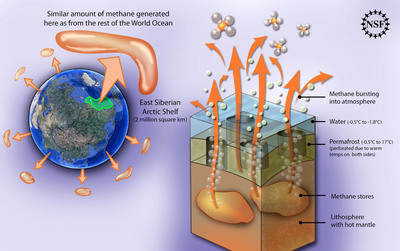
One potentially important environmental issue in the case of natural gas does not bear on the use of natural gas as a fuel, but arises from the fact that methane has extensive presence in the soil and waters of frozen regions in and surrounding the Arctic Ocean. Those regions have recently been warming as a result of increasing global temperatures, and methane is being released.
Methane is a greenhouse gas, about 20 times as powerful as carbon dioxide. It is present in large quantities in:
- the Arctic in natural gas deposits,
- in the permafrost layer on both exposed land and the submerged floor of the East Siberian Arctic Shelf,
- and as submarine methane hydrates.
The effects of Arctic warming on the global climate are as yet uncertain, but the potential for abrupt climate change due to this phenomenon has become a major concern for scientists worldwide. Some scientists have proposed that this could become the "tipping point" that sends climate change on the earth into an irreversible, positive feedback loop of increasing global warming.
The environmental dangers associated with methane hydrates center around:
- the extensive amount of methane hydrates present in both oceanic and land-based, permafrost environments,
- the vulnerability of frozen hydrates to increases in temperature, and
- the powerful greenhouse gas properties of methane, when compared to carbon dioxide.
In the case of permafrost, the potential for release of methane due to global warming is considerable and could lead to a "snowball" effect. If global warming produced an extensive thawing of permafrost, resulting in a release of copious amounts of methane into the atmosphere, this release would result in a positive feedback loop, with further warming of the environment, causing more thawing of permafrost, with the subsequent release of even more methane and more heating of the environment.